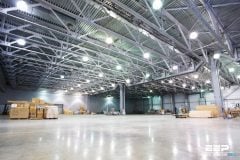Illuminance
Illuminance provided initially by a lighting installation will decrease in a gradual way during its use due to a reduction in lamp lumens, to lamps which burn down, and to accumulation of dirtiness in lamps, luminaires and surfaces of the room.

However, it is possible to maintain illuminance at or above the minimum permitted value (known as maintained value) cleaning the lighting equipment and the room surfaces as well as replacing burned down or used up lamps at adequate intervals, according to a previously agreed maintenance program.
The value for such maintenance program is indicated in Figure 1. Clearly for the case illustrated, illuminance in the non-maintained system will decrease up to a 40% of the initial value within the first three years and it will continue to decrease.
But with a yearly cleaning, relamping and paint changing every three years, illuminance reaches 60% of the initial value.

Factors to be considered in indoor lighting depreciation
Dirtiness in lamps and luminaires
For the most part, light loss may be attributed to dirtiness accumulated in lamps and light control surfaces (reflected, refracted or diffused) of luminaires.
Depreciation speed caused by dirtiness which accumulates on light control surfaces is affected by the tilt angle, finish, and surface temperature, by the luminaire ventilation degree or tightness, as well as by the atmospheric pollution degree surrounding the luminaire.
Depreciation in the emission of light may be reduced selecting appropriate luminaires for each place. Those luminaires with open bases and closed surfaces accumulate dirtiness more quickly than those with ventilation. In ventilated luminaires, convection currents take dust and dirtiness out through holes or slits in the canopy or reflector, and out of reflection surfaces.
In highly polluted environments, it is better to use sealed or dustproof luminaires. Some of them possess a filter inside which allows the necessary “breathing” to take place.
Dirtiness on the surfaces of the room
Dirtiness accummulated on ceilings (flat ceilings) and walls reduces their reflectance value and, thus, the amount of reflected light. The connection between this and the calculation of illuminance will obviously depend on the size of the room under study and on the luminaire light distribution.
The effect will be more pronounced in small rooms or when there is luminaires with an indirect component.
Depreciation of the lamp flux
Luminous performance of all lamps diminishes with use, but the speed of such diminution varies greatly according to types of lamps and manufacturers.
Hence, calculations for lighting must bear in mind specified depreciation of the luminous performance of each lamp in particular. It must be taken into account that data shown in figures are based on certain suppositions related to working conditions.
• Room temperature
• Lamp working position
• Supplied voltage
• Type of control equipment used, if relevant
Lamp failure
Average life of a lamp depends on the type of lamp used and, for discharge lamps, on the ignition cycle. Failures in lamps cause not only a reduction in illuminance levels, but also an inacceptable reduction in the lighting uniformity degree.
Maintenance factor (fm)
fm is defined as the ratio between illuminance produced by the lighting installation at a specified time, at the illuminance produced by the installation itself when it is new.
fm, thus, combines losses caused by lamp depreciation flux, luminaire depreciation and depreciation of the room surface. If each of these depreciation causes is quantified by a specific period of use, a general factor product of the three factors is obtained.
When the light loss factor for different maintenance situations is calculated, it is possible to predict the illuminance situation produced by the installation in relation to the time elapsed.
Resource: Lighting Engineering 2002 – Indalux











State and prove kelvin law for feeder design with reference to supply system